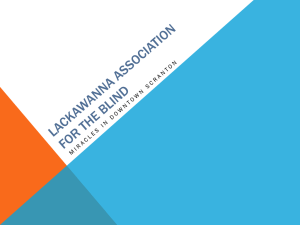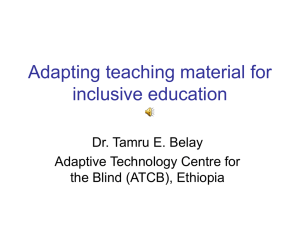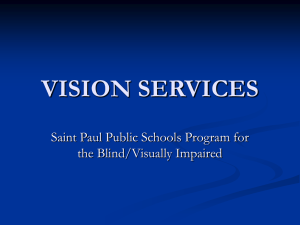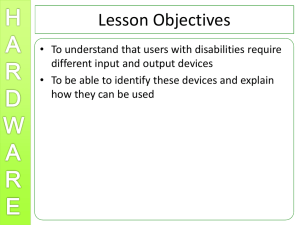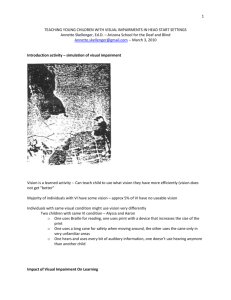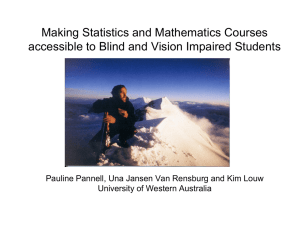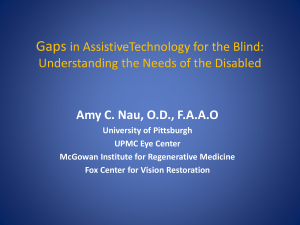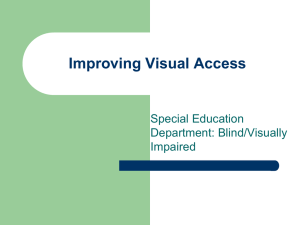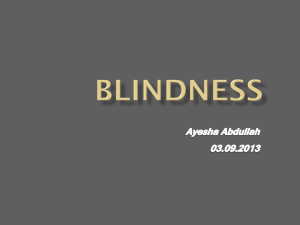KAT_BLIND - Maureen A. McQuiggan and Family
advertisement
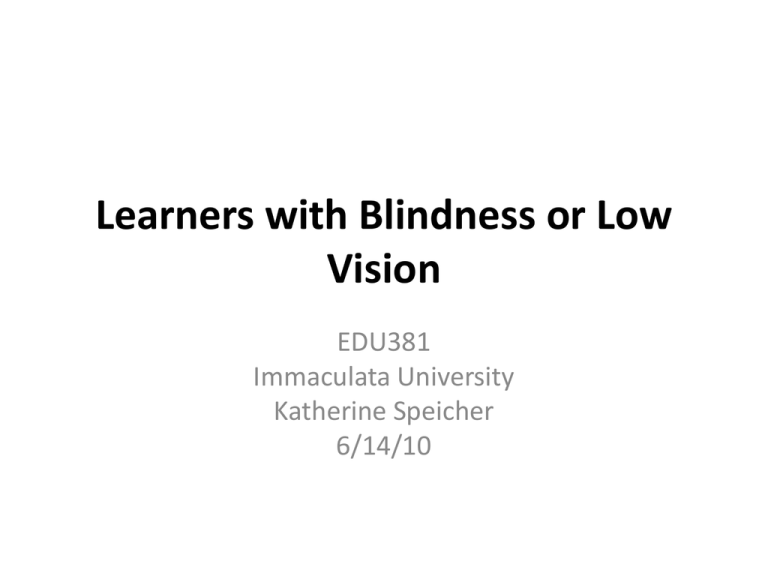
Learners with Blindness or Low Vision EDU381 Immaculata University Katherine Speicher 6/14/10 Definition and Classification: • The two most common ways of describing someone with visual impairment are the legal and educational definitions. Laypeople and medical professionals use the former; the latter is the one educators favor. The two major classifications are blindness and low vision. Legal Definition • The legal definition involves assessment of visual activity and field of vision. A person who is legally blind has visual acuity of 10/200 or less in the better eye even with correction (e.g. eyeglasses) or has a field of vision so narrow that its widest diameter subtends an angular distance no greater than 20 degrees. The fraction 20/200 means that the person sees at 20 feet what a person with normal vision sees at 200 feet. (Normal visual acuity is thus 20/20.) The inclusion of a narrowed field of vision in the legal definition means that a person may have 20/20 vision in the central field but severely restricted peripheral vision. Legal blindness qualifies a person for certain legal benefits, such as tax advantages and money for special materials. • In addition to this classification of blindness, there is a category referred to as low vision (sometimes referred to as partially sighted.) According to the legal classification system, persons who have low vision have visual acuity falling between 20/70 and 20/200 in the better eye with correction. Educational Definition • Many professionals, particularly educators, find the legal classification scheme inadequate. They have observed that visual acuity is not a very accurate predictor or how people will function or use whatever remaining sight they have. Although a small percentage of individuals who are legally blind have absolutely no vision, the majority can see to some degree. • Many who recognize the limitations of the legal definitions of blindness and low vision favor the educational definition, which stresses the method of reading instruction. For educational purposes, individuals who are blind are so severely impaired they must learn to read Braille, a system of raised dots by which people who are blind read with their fingertips. It consists of quadrangular cells containing from one to six dots whose arrangement denotes different letters and symbols. Alternatively, they use aural methods (audiotapes and records.) Those who have low vision can read print, even if they need adaptations such as magnifying devices or largeprint books. Psychological and Behavioral Characteristics • Language Development Most authorities believe that lack of vision does not have a very significant effect on the ability to understand and use language. Because auditory more than visual perception is the sensory modality through which we learn language, it’s not surprising that studies have found that people who are blind are not impaired in language functioning. The child who is blind is still able to hear language and might even be more motivated than the sighted child to use language because it’s the main channel through which he or she communicates with others. Intellectual Ability Performance on Standardized Intelligence Tests • At one time, it was popular for researchers to compare the intelligence of sighted people with that of persons with blindness. Most authorities now believe that such comparisons are virtually impossible because finding comparable test is so difficult. From what is known, there is no reason to believe that blindness results in lower intelligence. Conceptual Abilities • It is very difficult to assess the performance of children with visual impairment on laboratory-type tasks of conceptual ability. Many researchers, using conceptual tasks originally developed by noted psychologist Jean Piaget, have concluded that infants and very young children who are blind lag behind their sighted peers. This is usually attributed to the fact that they rely more on touch to arrive at conceptualizations of many objects, and touch is less efficient than sight. • However, these early delays don’t last for long, especially once the children begin to use language to gather information about their environment. Touch, however, remains a very critical sense throughout life for those who are blind. As one person who is blind described it, he “sees with his fingers.” Orientation and Mobility (O&M) These skills refer to the ability to have a sense of where one is in relation to other people, objects, and landmarks (orientation) and to move through the environment (mobility). O&M skills depend to a great extent on spatial ability. • Cognitive Mapping – A non sequential way of conceptualizing the spatial environment that allows a person who is visually impaired to know where several points in the environment are simultaneously. This allows for better mobility than does a strictly sequential conceptualization of the environment. • Obstacle Sense - A skill possessed by some people who are blind, whereby they can detect the presence of obstacles in their environments. Research has shown that it is not an indication of an extra sense, as popularly thought, but is the result of learning to detect subtly changes in pitches of high-frequency echoes. • Doppler Effect – The phenomenon of the pitch of a sound rising as the listener moves toward its source. Academic Achievement • Phonological Awareness – Learning to read Braille is similar in some important ways to learning to read print. Phonological awareness is an important component of learning to read print or Braille. Social Adjustment • Subtle Visual Cues – Those who are sighted take for granted how often we use visual cues to help us interact socially. Children with visual impairments often need to be taught directly how to use these cues. Facial expressions, such as smiling, are a good example of visual cues that don’t come spontaneously for persons who are visually impaired. Stereotypic Behaviors • Any of a variety of repetitive behaviors (e.g. eye rubbing) that are sometimes found in individuals who are blind, autistic, severely intellectually disabled, or psychotic. They are sometimes referred to as stereotypies or blindisms. Physical Symptoms/Characteristics • Signs of Possible Eye Trouble in Children If one or more of these signs appear, take your child to an eye doctor right away What do your child’s eyes look like? • Eyes don’t line up, one eye appears crossed or looks out • Eyelids are red-rimmed, crusted or swollen • Eyes are watery or red • How does your child act? • Rubs eyes a lot • Closes or covers one eye • Tilts head or thrusts head forward • Has trouble reading or doing other close-up work, or holds objects close to eyes to see • Blinks more than usual or seems cranky when doing close-up work • Things are blurry or hard to see • Squints eyes or frowns What does your child say? • “My eyes are itchy,” “my eyes are burning” or “my eyes feel scratchy.” • “I can’t see very well.” • After doing close-up work, your child says, “I feel dizzy,” “I have a headache” or “I feel sick/nauseous.” • “Everything looks blurry” or “I see double.” Diagnosis & Identification • Snellen chart – Used in determining visual acuity. The chart consists of rows of letters or Es arranged in different positions, and the person’s task is to indicate in what direction the “legs” of the E’s face. Each row corresponds to the distance at which a normally sighted person can discriminate the letters. It does not predict how accurately a child will be able to read print. Diagnosis & Identification • Functional Vision Assessment – Used by the vision teacher to determine how students use their vision in everyday situations. The teacher observes the student in his or her daily activities, taking note of how the student functions under a variety of conditions and on a variety of tasks. Potential Causes of Visual Impairment • Causes Affecting Children and Adults When considering both children and adults, the most common visual problems are the result of errors of refraction. Refraction refers to the bending of the light rays as they pass through the various structures (cornea, aqueous humor, pupil, lens, vitreous humor) of the eye. Myopia (nearsightedness), hyperopia (farsightedness), and astigmatism (blurred vision) are examples of refraction errors that affect central visual acuity. Although each can be serious enough to cause significant impairment (myopia and hyperopia are the most common impairments of low vision), wearing glasses or contact lenses usually can bring vision within normal limits. • Causes Primarily Affecting Children • For children, cortical visual impairment (CVI) is now the leading cause of visual impairment in the Western world. While most causes of visual impairment are due to abnormalities in the eye itself, CVI results from widespread damage to parts of the brain responsible for vision. • Several other visual impairments primarily affect children and are often due to prenatal causes, many of which are hereditary, such as congenital (meaning present at birth) cataracts and glaucoma may also be responsible. Another congenital condition is retinitis pigmentosa. This is a hereditary disease resulting in degeneration of the retina. It can start in infancy, early childhood, or teenage years. It usually causes the field of vision to narrow (tunnel vision) and also affects one’s ability to see in low light (night blindness.) Included in the “prenatal” category are infectious diseases that affect the unborn child, such as syphilis and rubella. • Retinopathy of Prematurity (ROP) results in abnormal growth of blood vessels in the eye, and began to appear in the 1940’s in premature infants. In the 1950’s, researchers determined that excessive concentrations of oxygen often administered to premature infants were causing blindness. • Strabismus is a condition in which the eyes are directed inward (crossed eyes) or outward • Nystagmus is a condition in which there are rapid involuntary movements of the eyes, usually causing dizziness or nausea, and sometimes indicates a brain malfunction and/or inner-ear problems. Instructional Strategies/SDI • Accommodations: These are changes in the way in which the child is treated o o o o o o o o o in order to best accommodate the child’s physical, cognitive, or emotional challenges. The instructor should allow extra time when needed, for tactual exploration, when appropriate, slower visual/Braille reading, etc. Co-teaching– The general and special education teacher should make time to collaborate and plan for student needs that may arise at any time. Encourage the use of aids/devices. Provide extra storage space for special equipment/materials. The instructor should read out loud what is being written on the board. Include the visually impaired student in as many class activities as possible. Scheduling accommodations - Extended time on tests for aid to read questions to child or for the child to use Braille. Special seating – If the student has low vision, seat he/she in the front of the classroom. Alternative assessments (required by IDEA) • Modifications: These change the academic or curricular demands made of a child to better fit the child’s ability. The student with little or no sight will possibly require special modifications in four major areas: Braille Literary Braille Nemeth Code Unified English Braille Portable Braille Notebooks Perkins Brailler Slate and Stylus Braille Bills • Use of Remaining Sight • • Large print books Magnifying Devices • Listening Skills • • The importance of listening skills for children who are blind or of low vision cannot be overemphasized. Teachers should provide a classroom environment as free from auditory distractions as possible. Listening skills are becoming more important than ever due to the increasing accessibility of recorded material. Listeners can play the material at normal speed, or can use a compressed-speech device that allows them to listen to about 50-275 words per minute. This method works by discarding very small segments of the speech. • Orientation and Mobility Training • • • • The Long Cane - a mobility aid used by individuals with visual impairment, who sweep it in a wide arc in front of them proper use requires considerable training. The long cane is the mobility aid of choice for most travelers who are blind. Human Guides - Human guides allow those with visual impairment to have the greatest freedom in moving about safely. However, most O&M specialists do not recommend that this be the primary means of navigation because it fosters too much dependence on other people. Guide Dog - Dogs trained for the purpose of helping people who are blind navigate the environment. Guide dogs are generally not recommended for children, as they require extensive training for the user. Tactile Maps - Embossed representations of the environment. Touching raised symbols representing streets, sidewalks, buildings, and other objects allows blind people to orient themselves to their surroundings. Link to Sample SDI • http://docs.google.com/viewer?a=v&q=cache:O4BZOKtrrU4J:w ww.cde.state.co.us/cdesped/download/pdf/blvLVRelatedGoalsObjectives.pdf+SDI+blind+visually+impaired+goal s&hl=en&gl=us&pid=bl&srcid=ADGEESjJognd_SvFkGbvpJ2pWQJ 99PCe-Hcx0XyEOnhYVH2xjzKPqG7jI63-oYA5ds7mBrfvfBS29LmKhRZcG1K224aZvoMncxtTPPSMf428o2bfeBmswqzhH24ppMvSEk2e4IEZjZ&sig=AHIEtbTucuolit_GpxL0Hj4J7D0vcK8NaA Sample Goal Assessments Academic goals for visually impaired students will often be the same as the goals set for the rest of the students, but many times the methods of assessment must be altered. • • • • Teachers can monitor progress in Braille skills involved in reading and mathematics using CBM (curriculum based management.) The Neale Analysis of Reading Ability-Braille Version – an assessment of reading skills that has been standardized for children with blindness or low-vision. Monitoring Functional Skills and Quality of Life - O & M instructors can monitor travel skills using GPS devices. Academic outcomes may be assessed using Braille versions of standardized academic tests. Parental Strategies • • • • • • • Early intervention – Researchers have documented that immediately after birth infants begin processing a wealth of visual information in their environment. This fact makes it easy to understand why intensive intervention should begin as early as possible to help the infant with visual impairment begin to explore the environment. Encourage and aid in O&M training. Encourage the use of aids/devices. Do not treat any person with visual impairments as helpless. Give praise or rewards when achievements are made. Aid in the teaching of and encourage independent living skills. Aid in the transition to adulthood and independence for adolescents with visual impairments. • Video Segment Western Pennsylvania School for Blind Children http://www.youtube.com/watch#!v=60PBjXXjmOo&feature=related • Useful Links www.preventblindness.org/children/trouble_signs.html www.mdsupport.org/snellen.html www.i-see,org/eyecharts.html www.preventblindness.org www.preventblindness.org/eye_tests/near_vision_test.html http://www.blindkids.org/ http://www.wonderbaby.org/index-topics/resources.html http://www.spedex.com/napvi/
